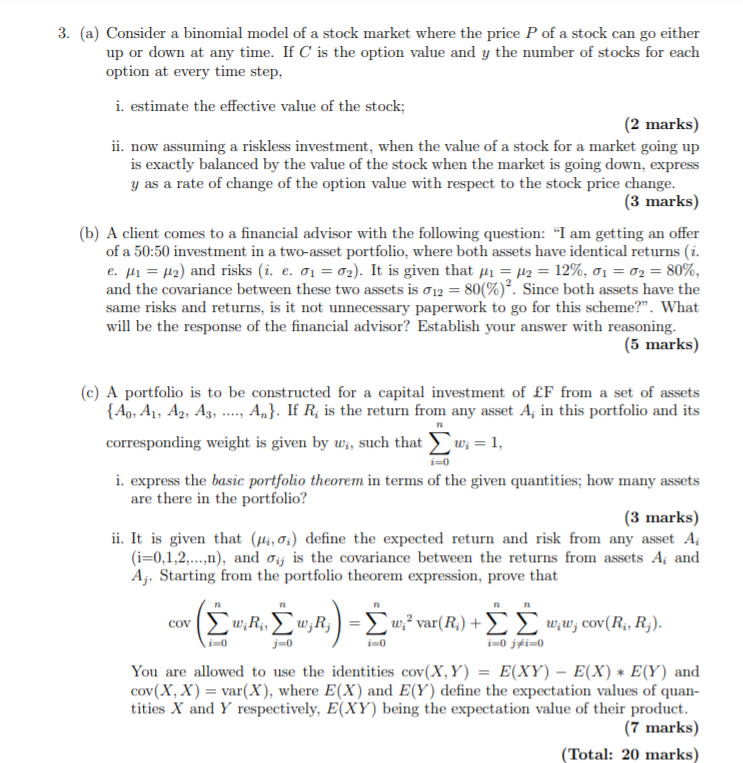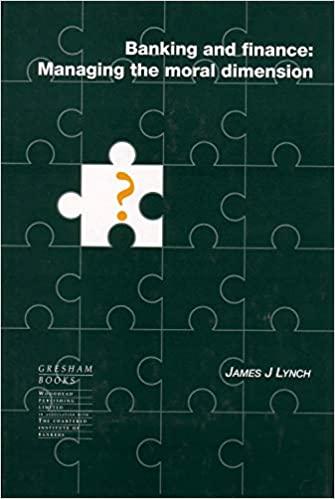
3. (a) Consider a binomial model of a stock market where the price of a stock can go either up or down at any time. If C is the option value and y the number of stocks for each option at every time step, i. estimate the effective value of the stock; (2 marks) ii. now assuming a riskless investment, when the value of a stock for a market going up is exactly balanced by the value of the stock when the market is going down, express y as a rate of change of the option value with respect to the stock price change. (3 marks) (b) A client comes to a financial advisor with the following question: "I am getting an offer of a 50:50 investment in a two-asset portfolio, where both assets have identical returns (i. e. H = H2) and risks (i. e. 01 = 02). It is given that 41 = H2 = 12%, 01 = 02 = 80%, and the covariance between these two assets is 012 = 80(%)? Since both assets have the same risks and returns, is it not unnecessary paperwork to go for this scheme?". What will be the response of the financial advisor? Establish your answer with reasoning. (5 marks) i=0 (c) A portfolio is to be constructed for a capital investment of F from a set of assets {A0, A1, A2, A3, ..., An}. If R; is the return from any asset A; in this portfolio and its corresponding weight is given by wi, such that wi=1, i. express the basic portfolio theorem in terms of the given quantities; how many assets are there in the portfolio? (3 marks) ii. It is given that (Mi, 01) define the expected return and risk from any asset Ai (i=0,1,2,...,n), and dij is the covariance between the returns from assets A; and Aj. Starting from the portfolio theorem expression, prove that (. . ) - (Zw;R, w;R;) m, var(R.) + ww, cov(R3, R,). R) + , (R 0 0 cov w ; j=0 i= 0.0 You are allowed to use the identities cov(X,Y) = E(XY) E(X) * E(Y) and cov(X, X) = var(X), where E(X) and E(Y) define the expectation values of quan- tities X and Y respectively, E(XY) being the expectation value of their product. (7 marks) (Total: 20 marks) 3. (a) Consider a binomial model of a stock market where the price of a stock can go either up or down at any time. If C is the option value and y the number of stocks for each option at every time step, i. estimate the effective value of the stock; (2 marks) ii. now assuming a riskless investment, when the value of a stock for a market going up is exactly balanced by the value of the stock when the market is going down, express y as a rate of change of the option value with respect to the stock price change. (3 marks) (b) A client comes to a financial advisor with the following question: "I am getting an offer of a 50:50 investment in a two-asset portfolio, where both assets have identical returns (i. e. H = H2) and risks (i. e. 01 = 02). It is given that 41 = H2 = 12%, 01 = 02 = 80%, and the covariance between these two assets is 012 = 80(%)? Since both assets have the same risks and returns, is it not unnecessary paperwork to go for this scheme?". What will be the response of the financial advisor? Establish your answer with reasoning. (5 marks) i=0 (c) A portfolio is to be constructed for a capital investment of F from a set of assets {A0, A1, A2, A3, ..., An}. If R; is the return from any asset A; in this portfolio and its corresponding weight is given by wi, such that wi=1, i. express the basic portfolio theorem in terms of the given quantities; how many assets are there in the portfolio? (3 marks) ii. It is given that (Mi, 01) define the expected return and risk from any asset Ai (i=0,1,2,...,n), and dij is the covariance between the returns from assets A; and Aj. Starting from the portfolio theorem expression, prove that (. . ) - (Zw;R, w;R;) m, var(R.) + ww, cov(R3, R,). R) + , (R 0 0 cov w ; j=0 i= 0.0 You are allowed to use the identities cov(X,Y) = E(XY) E(X) * E(Y) and cov(X, X) = var(X), where E(X) and E(Y) define the expectation values of quan- tities X and Y respectively, E(XY) being the expectation value of their product. (7 marks) (Total: 20 marks)







